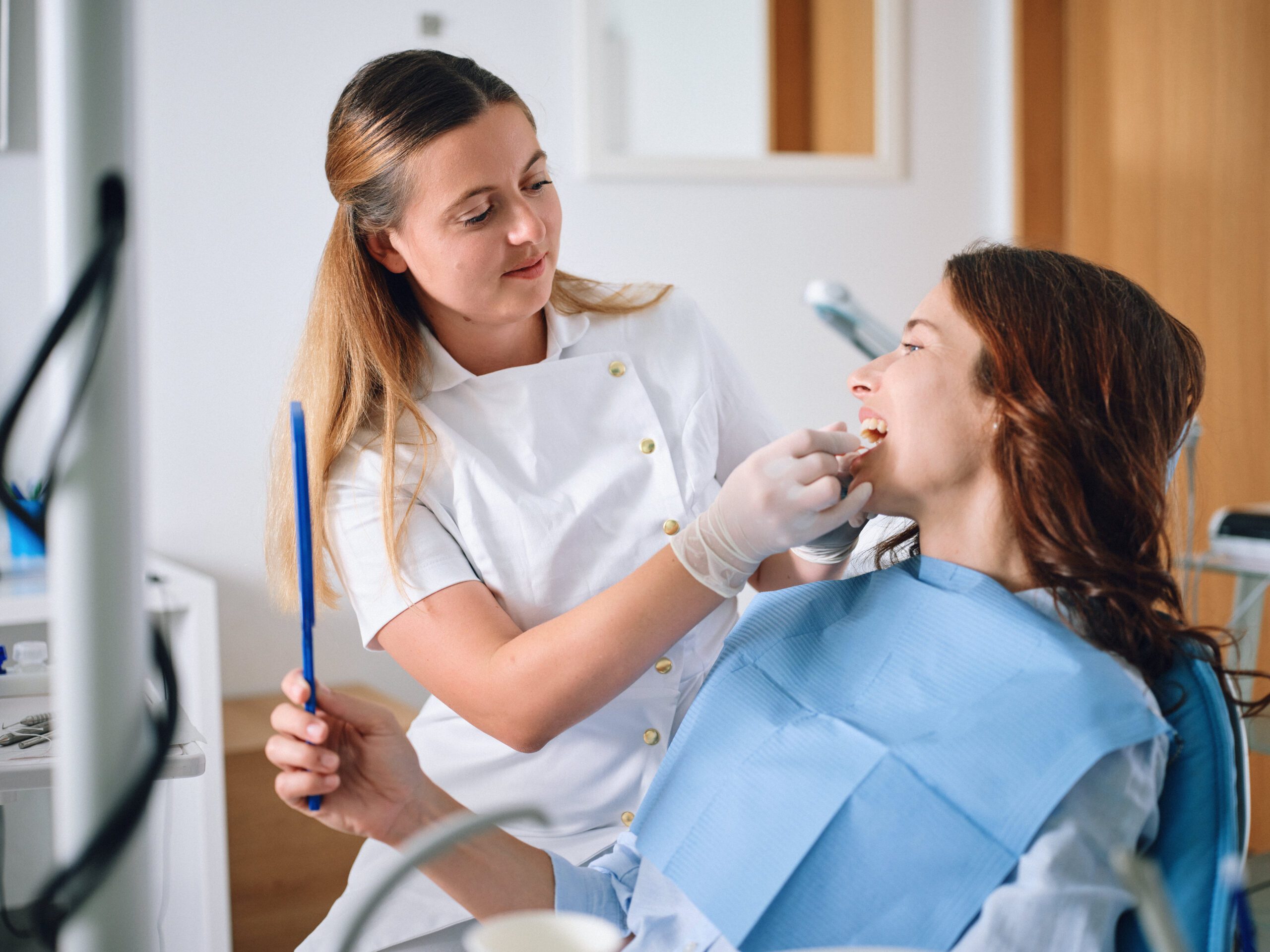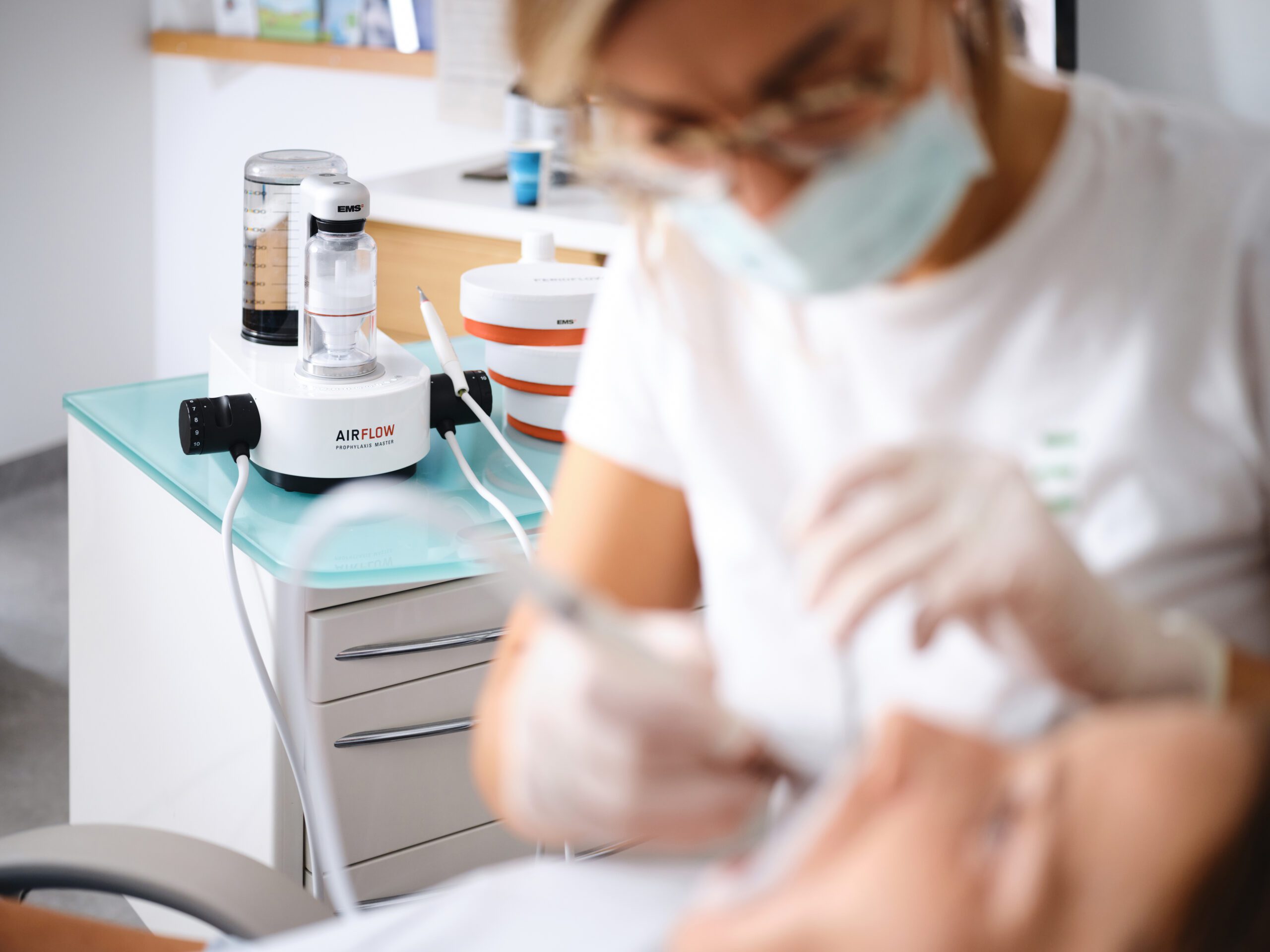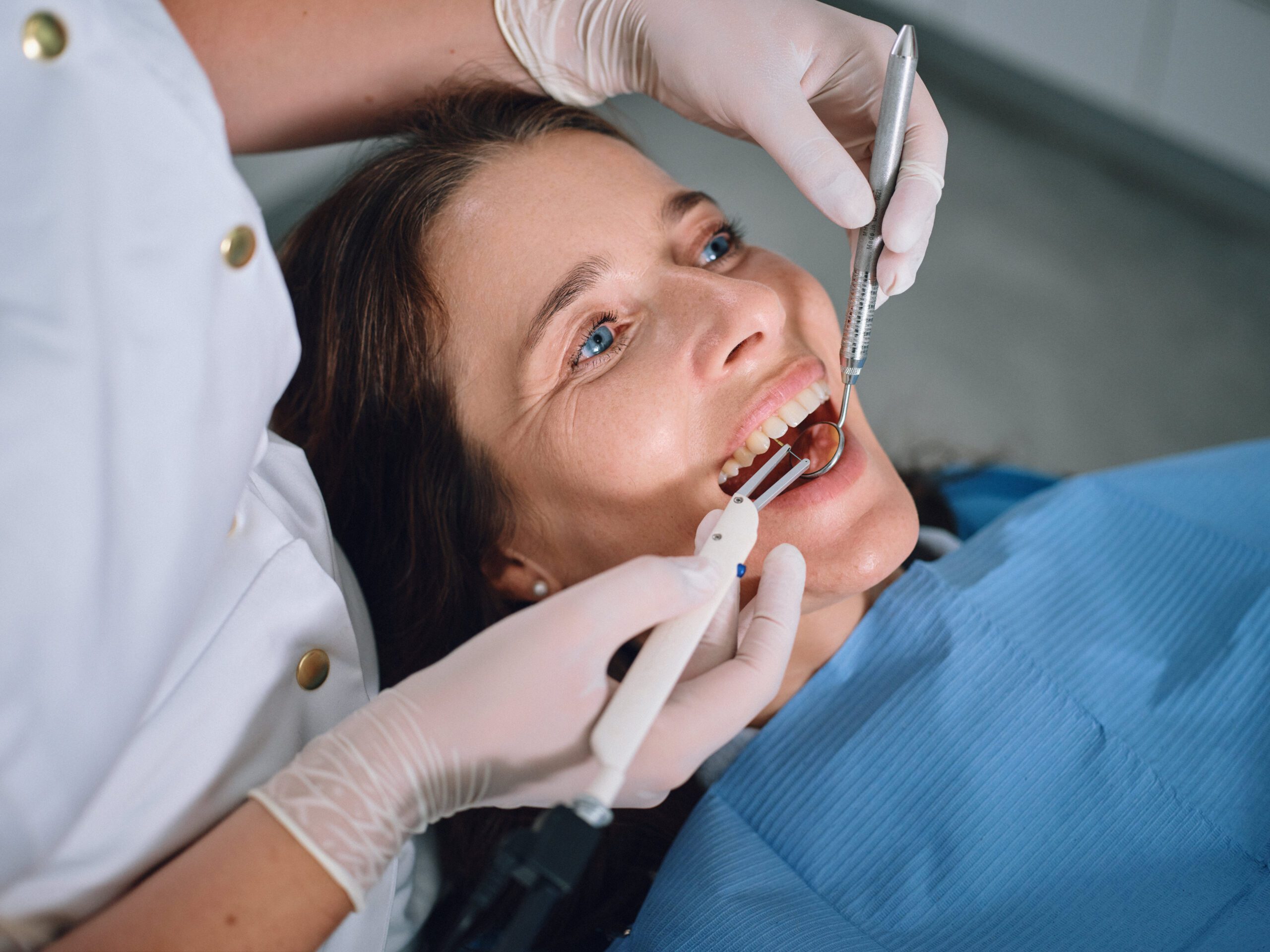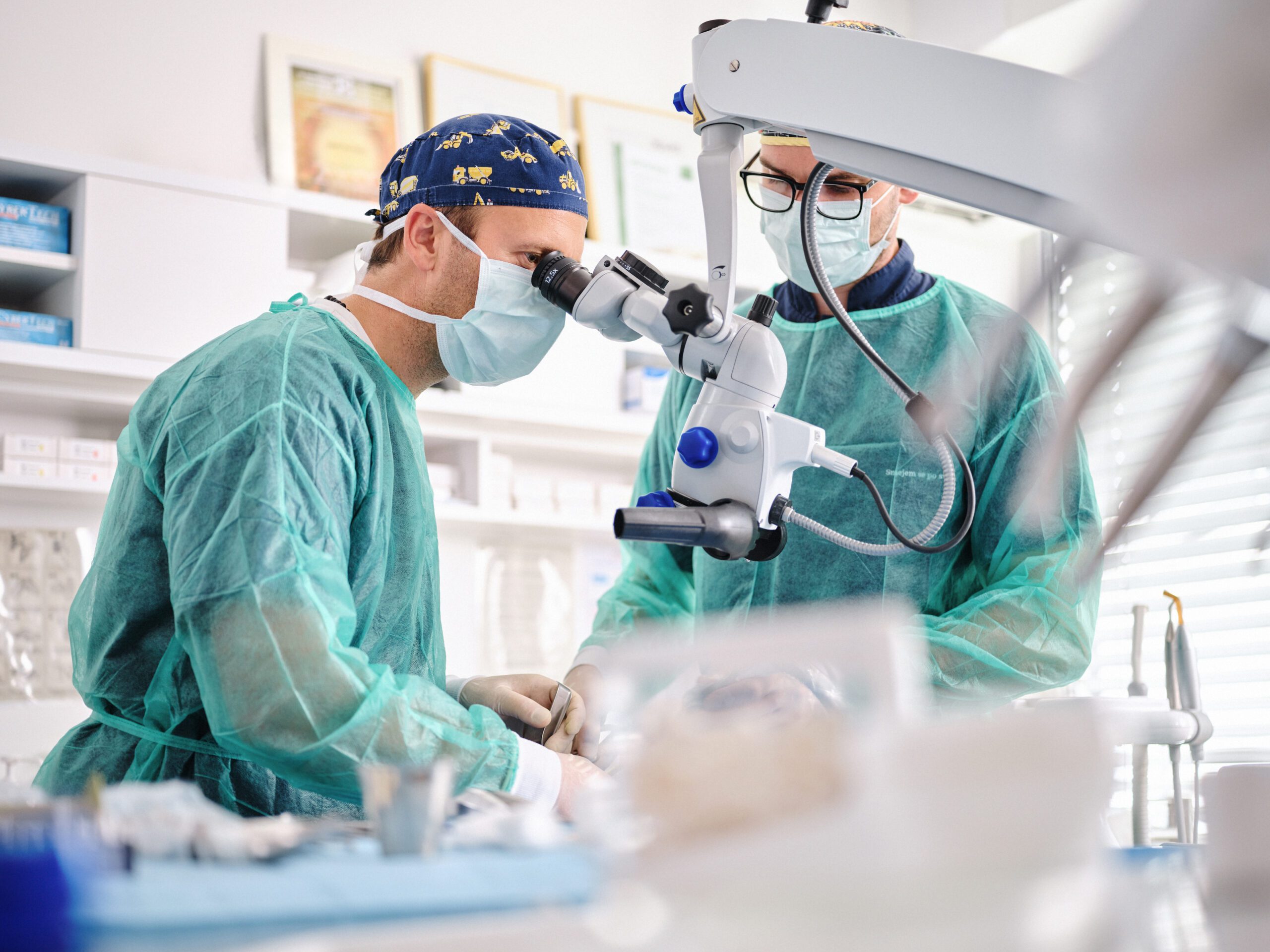Periodontal disease or Periodontitis Is it hard for you to accept the thought that you will lose your teeth as you age? You are absolutely right! Many still believe that tooth loss is an inevitable part of aging, but that simply isn’t true today. At Maha Integrative Dentistry, we believe that every individual deserves a healthy, stable, and beautiful smile for life.
The key to keeping your teeth is taking care of your gums, as infections of the gums and the bone around the tooth are the most common causes of tooth loss. With thoughtful concepts and modern technology, we help you maintain healthy teeth and gums, preventing the need for dentures, bridges, implants, and the pain that comes with such infections. Our passion is providing comprehensive oral care and timely treatment, enabling you to preserve every tooth. With the right approach and regular care, your smile can remain healthy and functional for life—because you deserve nothing but the best.
Periodontal disease begins with gum inflammation and, when it spreads to the bone, is classified as early, moderate, or advanced, depending on the amount of bone loss. Since it is an infection caused by anaerobic bacteria, it poses a serious threat not only to the stability of the teeth but also to the entire body. This inflammation can absolutely be stopped! According to recent research in Slovenia, as many as 98% of adults need care from an oral hygienist, and about 80% require cleaning of hard deposits or dental calculus. In around 40% of adults, gum inflammation has already progressed to periodontal disease, which requires scaling and root planing, while about 15% need surgical treatment. These figures are consistent with global statistics, which show that 10-15% of people suffer from advanced forms of periodontal disease. Early care for your gums is crucial to keeping your teeth for life.
A recent longitudinal study in Ljubljana showed that the need for periodontal treatment has significantly increased over the past 30 years. The study found no participants with healthy gums. This data highlights the importance of preventive measures and early intervention.
Periodontal disease is very dangerous and affects more than 80% of the European population!
Periodontal disease is a serious chronic inflammation that affects the gums, bone, roots, and connective tissue that connects the root to the bone. It is the most common chronic disease, caused by bacterial infection from dental plaque that is not removed through regular oral hygiene. The bacteria release toxins that attack the soft tissues in the oral cavity, leading to gum inflammation or gingivitis—the initial stage of the disease, where the gums are affected. If the infection progresses, periodontal disease develops, where the inflammation has already reached the deeper tissues, including the bone that supports the teeth.
The infection already brings nothing good locally, and it is further confirmed that bacteria, toxins, and a poorly regulated immune response invade the bloodstream and lymphatic system or travel through the extracellular space to distant parts of the body. In this way, they become a significant causal factor in cardiovascular diseases, diabetes, and other inflammatory conditions. Untreated periodontal disease thus not only threatens oral health but also affects the entire organism. Timely therapy and proper oral hygiene are key to preserving teeth and protecting overall health.
Proper and modern course of treatment for gum inflammation and periodontal disease.
1. Diagnostics and lessons on modern oral hygiene
Modern treatment of periodontal disease begins with a thorough diagnosis and instruction on proper oral hygiene. Diagnostics is carried out using advanced technologies, such as the Florida Probe system, which allows accurate measurement of the depth of periodontal pockets. This procedure helps the dentist or oral hygienist detect early signs of periodontal disease, such as bleeding gums and deep pockets, which are key indicators of inflammation of the periodontal tissues. The right diagnosis is the basis for planning effective treatment.
At the same time, lessons on modern oral hygiene are extremely important. Each individual needs a personalized approach to hygiene, as there is no universal technique that suits everyone. It is important that hygiene is adapted to the person and their condition, using appropriate techniques and tools. Proper care prevents further deterioration of the disease and maintains optimal gum and tooth health. Both diagnostic procedures and hygiene instruction are key to successful treatment.
2. Cleaning hard plaque
Hard dental plaque that accumulates above the gum level is removed with the help of ultrasonic removers and the advanced EMS Guided Biofilm Therapy system. This system enables the gentle but effective removal of hard and soft deposits, which are the main cause of gum inflammation (gingivitis). Hard plaque creates a favorable environment for bacteria, which can accumulate below the gum level and cause more serious inflammation, leading to periodontal disease (periodontitis). If these plaques are not removed in time, the inflammation spreads to the bone and supporting tissues, endangering the health of the teeth. This is why it is vital that you visit your dentist or oral hygienist regularly. Follow-up examinations are scheduled every 6 months, where advanced techniques such as EMS are used to remove plaque and prevent disease progression.
3. Cleaning dental pockets
Scaling and root planing is a key procedure in the treatment of periodontal disease, which affects the gums and supporting structures of the teeth. If dental plaque and bacteria are not removed in time, they also begin to accumulate below the level of the gums, in periodontal pockets. Bacteria above the gums are part of the normal oral flora and are mostly aerobic (live on oxygen). But when the bacteria penetrate under the gums, their character changes – anaerobic bacteria appear, which live without oxygen and are very destructive. These trigger an inflammatory response in the body that leads to the dissolution of the bone around the teeth, causing permanent damage.
Bacteria that cause inflammation are removed by mechanical peeling and smoothing of tooth roots and disinfection of dental pockets. This reduces the depth of the periodontal pockets, which makes cleaning easier and improves the health of the gums. This therapy stops the process of bone dissolution and prevents the progression of periodontal disease. The procedure is usually performed under local anesthesia and is painless.
For long-term results, regular examinations by an oral hygienist and adherence to recommended oral hygiene are essential.
4. Antibacterial pocket wash
After mechanical cleaning of periodontal pockets, it is important to remove the remaining bacteria and inflammatory factors that could cause a recurrence of the infection. Therefore, the spaces under and around the gums are washed with individual antibacterial solutions, which work to remove bacteria and reduce inflammation. The most commonly used are hydrogen peroxide, chlorhexidine, and saline, with each agent being used separately, depending on the specific needs and condition of the patient.
Hydrogen peroxide acts as an oxidant that effectively destroys bacteria by releasing oxygen, which helps to disinfect and reduce the number of pathogenic microorganisms. Chlorhexidine is a powerful antibacterial agent that is widely used for its long-term effectiveness against periodontal disease-causing bacteria. Studies show that chlorhexidine reduces inflammation and prevents reinfection. The physiological solution ensures gentle rinsing and removal of mechanical particles without irritating the tissues.
Each of these agents has a specific role in providing comprehensive and effective treatment, as the combination of different methods helps to improve healing and prevent further progression of the disease.
5. Laser treatment
The use of the Photon laser, which was developed and manufactured in Slovenia, is becoming more and more popular in periodontology due to its high efficiency and minimal invasiveness. Photon laser systems use two different wavelengths (Er and Nd), which enables precise targeted removal of diseased tissues, disinfection and stimulation of gum regeneration. Lasers are particularly effective in destroying bacteria in periodontal pockets, which reduces the risk of recurrent infections and improves long-term treatment results.
Laser treatment has many advantages. Among other things, less pain, less bleeding and swelling and accelerated healing compared to traditional methods. Laser procedures are extremely precise, which means less damage to the surrounding healthy tissue and a shorter recovery time. Because of these features, laser treatment is extremely popular with patients looking for modern and effective solutions for the treatment of periodontal disease. Procedures are faster and more comfortable, which brings greater satisfaction to patients.
6. Surgical treatment
Surgical treatment of periodontal disease is rarely necessary today, as our non-surgical protocol is extremely effective. Modern methods, such as mechanical cleaning, antibacterial rinsing, laser treatment with the Fotona laser, in most cases successfully stop the progression of the disease and stimulate tissue regeneration without the need for surgical interventions. These minimally invasive methods allow effective removal of bacteria and infected tissues, which greatly improves gum health and reduces the risk of further complications.
Surgical treatment is used only in cases where the periodontal disease has progressed significantly and non-surgical methods do not bring the desired results. In these rare cases, surgery allows deeper cleaning and regeneration of severely affected supporting tissues, such as bone.
Probiotics are gaining ground as a promising complementary treatment in periodontology. Recent studies show that certain strains of probiotics such as Lactobacillus and Bifidobacterium can significantly improve periodontal health by reducing inflammation, modulating the oral microbiota and inhibiting the growth of harmful bacteria such as Porphyromonas gingivalis. These beneficial bacteria compete with periodontal pathogens for attachment sites in the biofilm, reducing their colonization and harmfulness.
Clinical studies have shown that combining probiotics with conventional mechanical periodontal therapies, such as plaque removal and scaling and root planing, leads to better results. Probiotics help reduce the depth of periodontal pockets and loss of attachment, while reducing the levels of inflammatory molecules such as IL-1β and IL-6. This “lowering” of inflammation can contribute to slowing the progression of periodontal disease.
Probiotics have also been shown to be effective in the management of inflammation around implants, as we professionally call peri-implantitis and peri-implant mucositis, which are often uncontrollable. By disrupting biofilm formation, probiotics help reduce inflammation and improve the long-term stability of dental implants.
Although probiotics represent a promising addition to periodontal care, further research is needed to determine the optimal strains, doses, and duration of treatment for long-term success. Nevertheless, the use of probiotics in periodontal treatment represents an exciting development in dentistry, offering patients an additional tool to improve their oral health. In our house, we use Omni EM Ferment, which is in liquid and we also apply it to the cleaned dental pockets during the therapy, and you can also get it as a rinse to take home.
CONCLUDING REMARKS
Understanding the connection between periodontal disease and other systemic diseases, by taking into account the concepts of osteoimmunology, allows us a comprehensive approach to the diagnosis and treatment of these infections and the destructive response of the immune system. Managing periodontal disease is not only important for maintaining oral health, but also for preventing and managing various systemic diseases. In the future, further research in the field of osteoimmunology could contribute to the development of new therapeutic approaches that would simultaneously target inflammation and bone metabolism, thus improving treatment outcomes in both periodontal disease and other related diseases. In modern science, the concept of “leaky mouth” is emerging, similar to what happened years ago with leaky “gut” – leaky gut syndrome.
SOURCES
- Skalerič, U., et al. (2005). “Parodontalne bolezni v Sloveniji.”
- Skalerič, E., et al. (2019). “A Longitudinal Study of Periodontal Treatment Needs in a Ljubljana Population over a 30 year Period.”
- World Health Organization (WHO) Reports on Oral Health (2022).
- Del Pilar Angarita-Díaz M, Fong C, Medina D. Bacteria of healthy periodontal tissues as candidates of probiotics: a systematic review. Eur J Med Res. 2024 Jun 14;29(1):328. doi: 10.1186/s40001-024-01908-2. PMID: 38877601; PMCID: PMC11177362.
- Dr. Nagaraj B Kalburgi, Dr. Arati C Koregol, Dr. Anjaly Roy and Dr. Uzma Parveen Sultana. Probiotics in periodontal therapy: An enigmatic review. Int. J. Appl. Dent. Sci. 2024;10(1):200-205. DOI: 10.22271/oral.2024.v10.i1c.1911
-
Lo´ pez-Valverde N, Lo´ pez-Valverde A and Blanco Rueda JA (2024) The role of probiotic therapy on clinical parameters and human immune response in peri-implant diseases: a systematic review and meta-analysis of randomized clinical studies. Front. Immunol. 15:1371072.
doi: 10.3389/fimmu.2024.1371072 - Di Stefano M, Polizzi A, Santonocito S, Romano A, Lombardi T, Isola G. Impact of Oral Microbiome in Periodontal Health and Periodontitis: A Critical Review on Prevention and Treatment. Int J Mol Sci. 2022 May 5;23(9):5142. doi: 10.3390/ijms23095142. PMID: 35563531; PMCID: PMC9103139.
MAHA
Slovenska cesta 54, 1000 Ljubljana, Slovenija, Europe
Tel. +386 51 248 888
email: info@maha.clinic
Mon, Tue, Wed: 8:00 – 15:00
Thu: 12:30 – 20:00
Fri: 8:00 – 13:30
© Copyright 2024 – Maha / made by visualbraingravity



